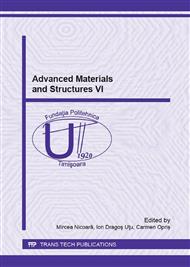p.237
p.243
p.249
p.255
p.261
p.267
p.272
p.278
p.283
Numerical Modeling of Thermal Field Distribution during Friction Stir Welding (FSW) of Dissimilar Materials
Abstract:
Friction Stir Welding (FSW) is an innovative solid state welding process, relatively new in industry, which allow welding of two or more materials which have very different properties, particularly thermal properties as fusion temperature, thermal expansion coefficient, specific heat and thermal conduction and have a predisposition to form intermetallic brittle phases, neither one of the components to be weld reach to the melting point. Being a solid state welding process temperature field is very important for the quality of the welded joint, and a lot of researches focused on this topic. This paper presents some results in modeling and estimation of thermal field developed during FSW of dissimilar joints, using Finite Element Analysis. Numerical modeling of thermal field allows engineers to predict, in advance, the evolution of temperature and to estimate the behavior of the welded materials during the welding process. This will reduce significantly the time and number of experiments that have to be carried out, in the process of establishing a good FSW technology, as well as reducing significantly the cost of the tests.
Info:
Periodical:
Pages:
261-266
Citation:
Online since:
August 2016
Authors:
Price:
Сopyright:
© 2016 Trans Tech Publications Ltd. All Rights Reserved
Share:
Citation:


